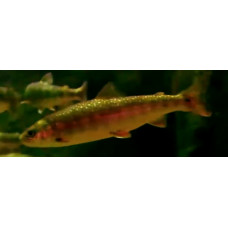Sockeye salmon (Oncorhynchus nerka) is a passage fish of the salmon family. It reaches a length of 80 cm. It is distinguished by a large number of gill stamens and large scales. The fins and meat are bright red. It inhabits the Pacific Ocean. It enters the rivers of Kamchatka and Anadyr, less in the rivers of the Kuril and Commander Islands. Marine fish, forms freshwater forms. Matures in 5-6 years. In the sea the fish is silvery, without spots, during spawning the body and fins are bright red, and the head is green. Spawns in lakes and keys, in places where spring waters come out. Fecundity up to 3.8 thousand eggs of red color, up to 4.7 mm in diameter. It feeds on crustaceans. It is an important object of fishery.
Representatives of this species reach a length of 80 cm, the weight is usually 1.5-3.5 kg, the maximum recorded weight is 7.7 kg. Sockeye salmon resembles chum salmon in size and body shape; it is easiest to distinguish these species by the number of gill stamens on the first gill arch: chum salmon have from 18 to 28, while Sockeye salmon always have more than 30. It becomes sexually mature most often in the 5th-6th year of life.
Unlike other Pacific salmon, it most often spawns in lakes, necessarily in places where keys come out. Homing in Sockeye salmon is expressed quite clearly: most fish return not only to the same lake, but also to the same spawning ground where they were born. Its entry into rivers usually begins in May and lasts until the end of July. The mating attire of Sockeye salmon is bright red (only the head is green), hence its second name - red. Juvenile Sockeye salmon emerge from their eggs in mid-winter, the fry live for a long time in freshwater, some lingering for 2 or 3 years, with only a few leaving for offshore pastures that same summer. Larger and higher-bodied Sockeye salmon spawn on those spawning grounds where depths are greater, hence the lowest average sizes of individuals from shallow streams. Spends from 1 to 4 years at sea.
The meat is not pink, as in other salmonids, but intensely red in color. Unlike all other salmonids, it particularly prefers relatively small but very fatty calanid crayfish, colored red with carotenoid pigments. These pigments pass from ingested crayfish into the meat of Sockeye salmon.
It inhabits the Pacific Ocean. It is widespread along the American coast, especially abundant in Alaska, southward to California. In Asian waters it is distributed from Hokkaido in the south to the Anadyr River in the north. It is most abundant off the coast of western and eastern Kamchatka. Less common in the northern Sea of Okhotsk and eastern Sakhalin.
Sockeye salmon
Tags: sockeye salmon




